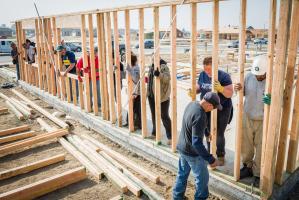Manufacturing Consent -
The Political Economy of the Mass Media by Noam Chomsky
|
Sunday, 27 June 2021
quote [ The combination of consumer tastes, low dollar value per volume building components, and the complexity of buildings inhibit efforts to scale.
Prefabbing construction is almost always more expensive than comparable site-built construction. High overhead, capital intensity, and high transportation costs eat away at cost savings. Adoption rates of new technologies are painfully slow. On-site integration can be challenging. ]
|
5th Earth said @ 11:16pm GMT on 27th June
I did see one very intriguing semi-prefab house concept that involved basically a shipping container with a self-contained industrial laser cutter scaled for 4x8 plywood sheets. The cutter makes slot-and tab pieces that hammer together into construction blocks of various sizes and shapes, which are in turn assembled into the building.
By using cheap, commonly available material (4x8 plywood is about as common as it gets) and making the "factory" very universal and easily transportable (one machine can make any house design its programmed for), you can get a lot of the advantages of prefab construction (fast, easy, and accurate assembly from pre-designed parts) but can lose most of the transportation expense of shipping the actual prefab parts themselves. And, if adjustments are necessary or parts are damaged, they can be made on-site in real time. (in the example I saw, one of the walls was a coming out a little longer than it should have, so they just adjusted the pattern to make it shorter) Labor is still pretty cheap too--one tech to run the CNC stuff, and then just a bunch of guys with mallets that only need to be smart enough to follow Lego directions.
5th Earth said @ 11:23pm GMT on 27th June
I did see one very intriguing semi-prefab house concept that involved basically a shipping container with a self-contained CNC router scaled for 4x8 plywood sheets. The cutter makes slot-and tab pieces that hammer together into construction blocks of various sizes and shapes, which are in turn assembled into the building. ("Facit" was the name of the company)
By using cheap, commonly available material (4x8 plywood is about as common as it gets) and making the "factory" very universal and easily transportable (one machine can make any house design its programmed for), you can get a lot of the advantages of prefab construction (fast, easy, and accurate assembly from pre-designed parts) but can lose most of the transportation expense of shipping the actual prefab parts themselves. And, if adjustments are necessary or parts are damaged, they can be made on-site in real time. (in the example I saw, one of the walls was a coming out a little longer than it should have, so they just adjusted the pattern to make it shorter) Labor is still pretty cheap too--one tech to run the CNC stuff, and then just a bunch of guys with mallets that only need to be smart enough to follow Lego directions.
5th Earth said @ 11:31pm GMT on 27th June
I did see one very intriguing semi-prefab house concept that involved basically a shipping container with a self-contained CNC router scaled for 4x8 plywood sheets. The cutter makes slot-and tab pieces that hammer together into construction blocks of various sizes and shapes, which are in turn assembled into the building. ("Facit" was the name of the company)
By using cheap, commonly available material (4x8 plywood is about as common as it gets) and making the "factory" very universal and easily transportable (one machine can make any house design its programmed for), you can get a lot of the advantages of prefab construction (fast, easy, and accurate assembly from pre-designed parts) but can lose most of the transportation expense of shipping the actual prefab parts themselves. And, if adjustments are necessary or parts are damaged, they can be made on-site in real time. (in the example I saw, one of the walls was a coming out a little longer than it should have, so they just adjusted the pattern to make it shorter) Labor is still pretty cheap too--one tech to run the CNC stuff, and then just a bunch of guys with mallets and nailguns that only need to be smart enough to follow Lego directions.
<-- Entry / Current Comment
5th Earth said @ 11:16pm GMT on 27th June [Score:1 Interesting]
I did see one very intriguing semi-prefab house concept that involved basically a shipping container with a self-contained CNC router scaled for 4x8 plywood sheets. The cutter makes slot-and tab pieces that hammer together into construction blocks of various sizes and shapes, which are in turn assembled into the building. ("Facit" was the name of the company)
By using cheap, commonly available material (4x8 plywood is about as common as it gets) and making the "factory" very universal and easily transportable (one machine can make any house design its programmed for), you can get a lot of the advantages of prefab construction (fast, easy, and accurate assembly from pre-designed parts) but can lose most of the transportation expense of shipping the actual prefab parts themselves. And, if adjustments are necessary or parts are damaged, they can be made on-site in real time. (in the example I saw, one of the walls was a coming out a little longer than it should have, so they just adjusted the pattern to make it shorter) Labor is still pretty cheap too--one tech to run the CNC stuff, and then just a bunch of guys with mallets and nailguns that only need to be smart enough to follow Lego directions.


More here: https://constructionphysics.substack.com/p/why-did-agriculture-mechanize-and